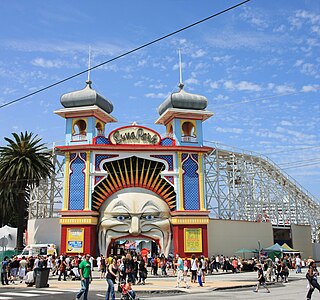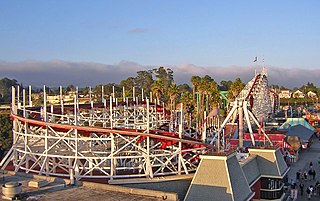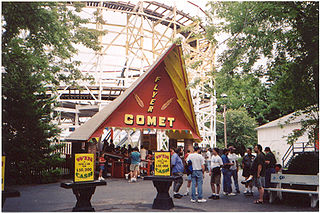
A roller coaster inversion is a roller coaster element in which the track turns riders upside-down and then returns them to an upright position. Early forms of inversions were circular in nature and date back to 1848 on the Centrifugal railway in Paris. These vertical loops produced massive g-force that was often dangerous to riders. As a result, the element eventually became non-existent with the last rides to feature the looping inversions being dismantled during the Great Depression. In 1975, designers from Arrow Development created the corkscrew, reviving interest in the inversion during the modern age of steel roller coasters. Elements have since evolved from simple corkscrews and vertical loops to more complex inversions such as Immelmann loops and cobra rolls. The Smiler at Alton Towers holds the world record for the number of inversions on a roller coaster with 14.

Philadelphia Toboggan Coasters (PTC) is one of the oldest existing roller coaster manufacturing companies in the world. Based in Hatfield, Pennsylvania, it was established in 1904 by Henry Auchey and Chester Albright under the name Philadelphia Toboggan Company. The company manufactured carousels, wooden roller coasters, toboggans and later, roller coaster trains.

Six Flags New England, formerly known as Gallup's Grove (1870–1886), Riverside Grove (1887–1911), Riverside Park (1912–1995) and Riverside: The Great Escape (1996–2000), is an amusement park located in Agawam, Massachusetts, a western suburb of Springfield, Massachusetts. Opening in the late 19th century, it is the oldest amusement park in the Six Flags chain, acquired by Premier Parks in 1996 and rebranded Six Flags New England in 2000. Superman The Ride is among the park's most notable rides, having appeared as a highly ranked roller coaster in the annual Golden Ticket Awards from Amusement Today since the ride opened in 2000.

Luna Park Melbourne is a historic amusement park located on the foreshore of Port Phillip Bay in St Kilda, Melbourne, Victoria. It opened on 13 December 1912, with a formal opening a week later, and has been operating almost continuously ever since. It is the oldest Luna Park currently operating in the world.
Southport Pleasureland is an amusement park located in Southport, Merseyside, England. The park originally operated from 1913 to 2006 as Pleasureland Theme Park under the ownership of the Blackpool Pleasure Beach company. In 2007, the park re-opened under the ownership of Norman Wallis.

Whizzer, originally named Willard's Whizzer, is a steel roller coaster located at Six Flags Great America in Gurnee, Illinois, United States. Designed by Werner Stengel and built by Anton Schwarzkopf, the Speedracer model was one of two identical roller coasters built for the Marriott Corporation in time for the debut of their Great America parks in 1976.

The Comet was a twister-layout wooden roller coaster that operated in the now defunct Lincoln Park in Massachusetts. It operated from 1946 until 1987.

The Giant Dipper is a historic wooden roller coaster located at the Santa Cruz Beach Boardwalk, an amusement park in Santa Cruz, California. The Giant Dipper, which replaced the Thompson's Scenic Railway, took 47 days to build and opened on May 17, 1924 at a cost of $50,000. With a height of 70 feet (21 m) and a speed of 55 miles per hour (89 km/h), it is one of the most popular wooden roller coasters in the world. As of 2012, over 60 million people have ridden the Giant Dipper since its opening. The ride has received several awards such as being named a National Historic Landmark, a Golden Age Coaster award, and a Coaster Landmark award.
Mountain Park, located on Mount Tom in Holyoke, Massachusetts, was originally built as a trolley park by the Holyoke Street Railway Company. Trolley parks were built just outside populated areas to encourage trolley usage on weekends. The Holyoke Street Railway company created two attractions, Mountain Park toward the base of Mount Tom, and a large house on the summit of the mountain.

The Wild One is a wooden roller coaster at Six Flags America in Prince George's County, Maryland. It features a 450° spiral helix and a series of bunny hills that produce a significant amount of air time. The wooden coaster was previously known as Giant Coaster when it was located at Paragon Park in Hull, Massachusetts. It operated there from 1917 to 1984. It is the oldest coaster in any Six Flags park.
John A. Miller was an American roller coaster designer and builder, inventor, and businessman. Miller patented over 100 key roller coaster components, and is widely considered the "father of the modern high-speed roller coaster." During his lifetime, he participated in the design of approximately 150 coasters and was a key business partner and mentor to other well-known roller coaster designers, Harry C. Baker and John C. Allen.

Whalom Park was an amusement park located on Lake Whalom in Lunenburg, Massachusetts, that operated from 1893 to 2000. The site was redeveloped into a 240-unit condominium complex.

Camden Park is a twenty-six acre amusement park located near Huntington, West Virginia. Established in 1903 as a picnic spot by the Camden Interstate Railway Company, it is one of only thirteen trolley parks that remain open in the United States. Whereas most trolley parks were located at the end of trolley lines, Camden Park is unusual in that it was built where riders traveling between Huntington and nearby cities would stop to change lines. Not long after opening, the park soon gained a carousel and other roadside attractions. Camden Park is West Virginia's only amusement park. The park is home to more than thirty rides and attractions, including a full-size traditional wooden roller coaster, the Big Dipper, and several other vintage rides.

Chippewa Lake Park is an abandoned amusement park located in Chippewa Lake, Ohio, Medina County. It operated from 1878 through 1978, after the final owner, Continental Business Enterprises closed it due to a lack of attendance. The rides and structures were left largely untouched and unmaintained for over 40 years.

Joyland Amusement Park was an amusement park in Wichita, Kansas, United States. It was in continuous operation for 55 years, from June 12, 1949, to 2004, closing permanently in 2006. It was once the largest theme park in central Kansas and featured a wooden roller coaster and 15 other rides.

Flyer Comet was a wooden roller coaster located at Whalom Park in Lunenburg, Massachusetts. The roller coaster was built in 1940 and operated until is permanent closure in 2000. In 2006, after the lift motor and part of its electronics were gutted, Flyer Comet was demolished. The tracks were then reclaimed by the park.

Crystal Beach Park was an amusement park in Crystal Beach, Ontario from 1888 to 1989. It was serviced by the Canadiana passenger ferry in Buffalo, making it a popular tourist destination for both Canadians and Americans.
Known by a variety of names over its 101-year existence, Rocky Glen Park was a park near Moosic, Pennsylvania. Founded by Arthur Frothingham in 1886 as a picnic park, it was transformed into an amusement park by engineer and entrepreneur Frederick Ingersoll in 1904. The trolley park was a popular Pennsylvania attraction that featured rides, arcades, and restaurants – even as a "wild west" theme park in the 1970s – until its closure in 1987.

The history of Hersheypark begins with the founding of the town of Hershey in 1903. Milton Hershey, The owner of the Hershey Chocolate Company surveyed a nearby area of land, which was to become a leisure park for the employees of his chocolate company. People began visiting the grounds of the future park in 1904 and 1905, while the park's first pavilion was built in the fall of 1905. The park was formally opened on May 30, 1906, when it opened as Hershey Park. The park slowly added rides until 1923, when the first roller coaster, the Wild Cat, was built. From then on, rides were regularly added, except during World War II. The park was redeveloped into Hersheypark in 1970, through a multi-phase project. Since then, it has added ten roller coasters, expanded to over 110 acres, and features many other attractions including shows with sea lions, well-known acts including Weird Al Yankovic and Duff Goldman from Charm City Cakes in the Hersheypark Amphitheater, and a short-lived laser light show.
Vernon Keenan (1886-1964) was an American roller coaster designer best known for his involvement with the Cyclone at Coney Island.
















